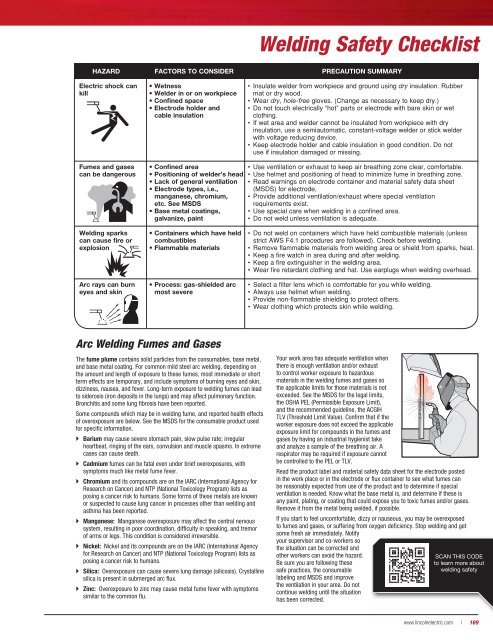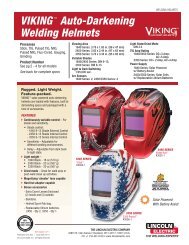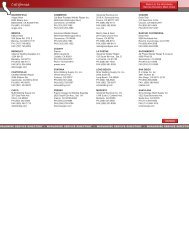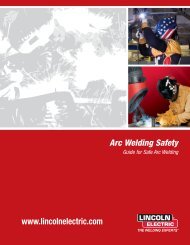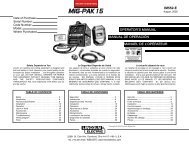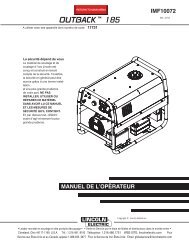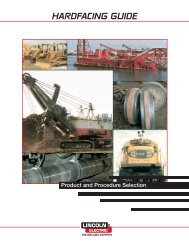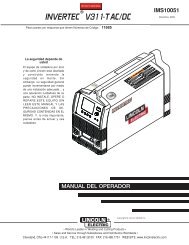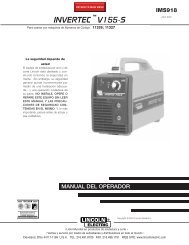Lincoln Electric Welding & Cutting Solutions Equipment Catalog
Lincoln Electric Welding & Cutting Solutions Equipment Catalog
Lincoln Electric Welding & Cutting Solutions Equipment Catalog
You also want an ePaper? Increase the reach of your titles
YUMPU automatically turns print PDFs into web optimized ePapers that Google loves.
Arc <strong>Welding</strong> Fumes and Gases<br />
The fume plume contains solid particles from the consumables, base metal,<br />
and base metal coating. For common mild steel arc welding, depending on<br />
the amount and length of exposure to these fumes, most immediate or short<br />
term effects are temporary, and include symptoms of burning eyes and skin,<br />
dizziness, nausea, and fever. Long-term exposure to welding fumes can lead<br />
to siderosis (iron deposits in the lungs) and may affect pulmonary function.<br />
Bronchitis and some lung fibrosis have been reported.<br />
Some compounds which may be in welding fume, and reported health effects<br />
of overexposure are below. See the MSDS for the consumable product used<br />
for specific information.<br />
Barium may cause severe stomach pain, slow pulse rate; irregular<br />
heartbeat, ringing of the ears, convulsion and muscle spasms. In extreme<br />
cases can cause death.<br />
Cadmium fumes can be fatal even under brief overexposures, with<br />
symptoms much like metal fume fever.<br />
Chromium and its compounds are on the IARC (International Agency for<br />
Research on Cancer) and NTP (National Toxicology Program) lists as<br />
posing a cancer risk to humans. Some forms of these metals are known<br />
or suspected to cause lung cancer in processes other than welding and<br />
asthma has been reported.<br />
Manganese: Manganese overexposure may affect the central nervous<br />
system, resulting in poor coordination, difficulty in speaking, and tremor<br />
of arms or legs. This condition is considered irreversible.<br />
Nickel: Nickel and its compounds are on the IARC (International Agency<br />
for Research on Cancer) and NTP (National Toxicology Program) lists as<br />
posing a cancer risk to humans.<br />
Silica: Overexposure can cause severe lung damage (silicosis). Crystalline<br />
silica is present in submerged arc flux.<br />
Zinc: Overexposure to zinc may cause metal fume fever with symptoms<br />
similar to the common flu.<br />
<strong>Welding</strong> Safety Checklist<br />
HAZARD FACTORS TO CONSIDER PRECAUTION SUMMARY<br />
<strong>Electric</strong> shock can • Wetness • Insulate welder from workpiece and ground using dry insulation. Rubber<br />
kill • Welder in or on workpiece mat or dry wood.<br />
• Confined space • Wear dry, hole-free gloves. (Change as necessary to keep dry.)<br />
• Electrode holder and • Do not touch electrically “hot” parts or electrode with bare skin or wet<br />
cable insulation clothing.<br />
• If wet area and welder cannot be insulated from workpiece with dry<br />
insulation, use a semiautomatic, constant-voltage welder or stick welder<br />
with voltage reducing device.<br />
• Keep electrode holder and cable insulation in good condition. Do not<br />
use if insulation damaged or missing.<br />
Fumes and gases • Confined area • Use ventilation or exhaust to keep air breathing zone clear, comfortable.<br />
can be dangerous • Positioning of welder’s head • Use helmet and positioning of head to minimize fume in breathing zone.<br />
• Lack of general ventilation • Read warnings on electrode container and material safety data sheet<br />
• Electrode types, i.e., (MSDS) for electrode,<br />
manganese, chromium, • Provide additional ventilation/exhaust where special ventilation<br />
etc. See MSDS requirements exist.<br />
• Base metal coatings, • Use special care when welding in a confined area.<br />
galvanize, paint • Do not weld unless ventilation is adequate.<br />
<strong>Welding</strong> sparks • Containers which have held • Do not weld on containers which have held combustible materials (unless<br />
can cause fire or combustibles strict AWS F4.1 procedures are followed). Check before welding.<br />
explosion • Flammable materials • Remove flammable materials from welding area or shield from sparks, heat.<br />
• Keep a fire watch in area during and after welding.<br />
• Keep a fire extinguisher in the welding area.<br />
• Wear fire retardant clothing and hat. Use earplugs when welding overhead.<br />
Arc rays can burn • Process: gas-shielded arc • Select a filter lens which is comfortable for you while welding.<br />
eyes and skin most severe • Always use helmet when welding.<br />
• Provide non-flammable shielding to protect others.<br />
• Wear clothing which protects skin while welding.<br />
Your work area has adequate ventilation when<br />
there is enough ventilation and/or exhaust<br />
to control worker exposure to hazardous<br />
materials in the welding fumes and gases so<br />
the applicable limits for those materials is not<br />
exceeded. See the MSDS for the legal limits,<br />
the OSHA PEL (Permissible Exposure Limit),<br />
and the recommended guideline, the ACGIH<br />
TLV (Threshold Limit Value). Confirm that if the<br />
worker exposure does not exceed the applicable<br />
exposure limit for compounds in the fumes and<br />
gases by having an industrial hygienist take<br />
and analyze a sample of the breathing air. A<br />
respirator may be required if exposure cannot<br />
be controlled to the PEL or TLV.<br />
Read the product label and material safety data sheet for the electrode posted<br />
in the work place or in the electrode or flux container to see what fumes can<br />
be reasonably expected from use of the product and to determine if special<br />
ventilation is needed. Know what the base metal is, and determine if these is<br />
any paint, plating, or coating that could expose you to toxic fumes and/or gases.<br />
Remove it from the metal being welded, if possible.<br />
If you start to feel uncomfortable, dizzy or nauseous, you may be overexposed<br />
to fumes and gases, or suffering from oxygen deficiency. Stop welding and get<br />
some fresh air immediately. Notify<br />
your supervisor and co-workers so<br />
the situation can be corrected and<br />
other workers can avoid the hazard.<br />
Be sure you are following these<br />
safe practices, the consumable<br />
labeling and MSDS and improve<br />
the ventilation in your area. Do not<br />
continue welding until the situation<br />
has been corrected.<br />
SCAN THIS CODE<br />
to learn more about<br />
welding safety<br />
www.lincolnelectric.com | 169


